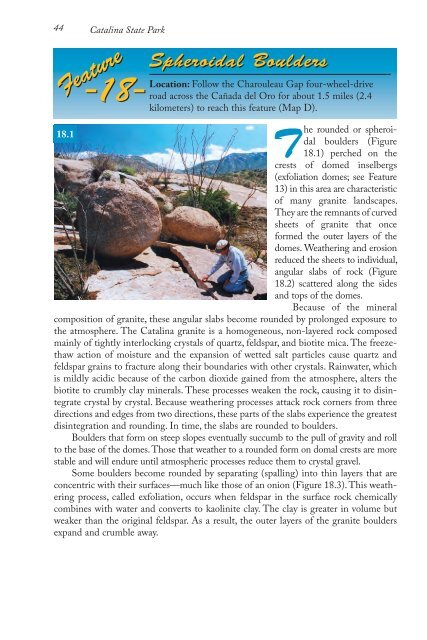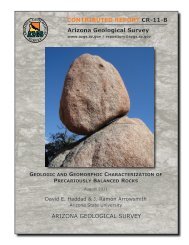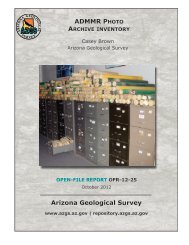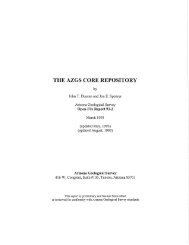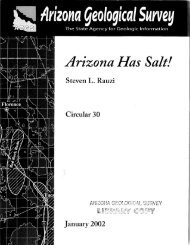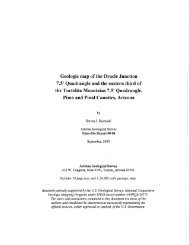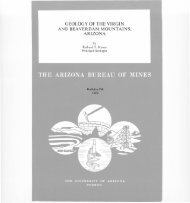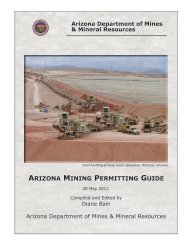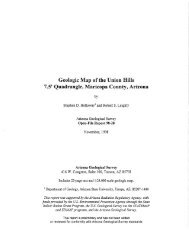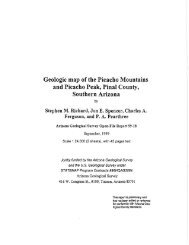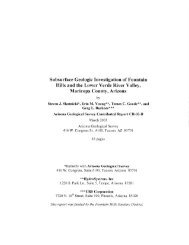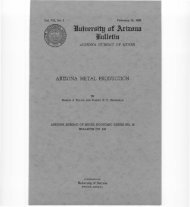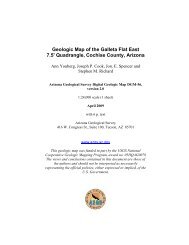A Guide to the Geology of Catalina State - AZGS Document Repository
A Guide to the Geology of Catalina State - AZGS Document Repository
A Guide to the Geology of Catalina State - AZGS Document Repository
You also want an ePaper? Increase the reach of your titles
YUMPU automatically turns print PDFs into web optimized ePapers that Google loves.
44<br />
<strong>Catalina</strong> <strong>State</strong> Park<br />
-18-<br />
Feature Feature<br />
Spheroidal Boulders<br />
Location: Follow <strong>the</strong> Charouleau Gap four-wheel-drive<br />
road across <strong>the</strong> Cañada del Oro for about 1.5 miles (2.4<br />
kilometers) <strong>to</strong> reach this feature (Map D).<br />
18.1<br />
The rounded or spheroidal<br />
boulders (Figure<br />
18.1) perched on <strong>the</strong><br />
crests <strong>of</strong> domed inselbergs<br />
(exfoliation domes; see Feature<br />
13) in this area are characteristic<br />
<strong>of</strong> many granite landscapes.<br />
They are <strong>the</strong> remnants <strong>of</strong> curved<br />
sheets <strong>of</strong> granite that once<br />
formed <strong>the</strong> outer layers <strong>of</strong> <strong>the</strong><br />
domes. Wea<strong>the</strong>ring and erosion<br />
reduced <strong>the</strong> sheets <strong>to</strong> individual,<br />
angular slabs <strong>of</strong> rock (Figure<br />
18.2) scattered along <strong>the</strong> sides<br />
and <strong>to</strong>ps <strong>of</strong> <strong>the</strong> domes.<br />
Because <strong>of</strong> <strong>the</strong> mineral<br />
composition <strong>of</strong> granite, <strong>the</strong>se angular slabs become rounded by prolonged exposure <strong>to</strong><br />
<strong>the</strong> atmosphere. The <strong>Catalina</strong> granite is a homogeneous, non-layered rock composed<br />
mainly <strong>of</strong> tightly interlocking crystals <strong>of</strong> quartz, feldspar, and biotite mica. The freezethaw<br />
action <strong>of</strong> moisture and <strong>the</strong> expansion <strong>of</strong> wetted salt particles cause quartz and<br />
feldspar grains <strong>to</strong> fracture along <strong>the</strong>ir boundaries with o<strong>the</strong>r crystals. Rainwater, which<br />
is mildly acidic because <strong>of</strong> <strong>the</strong> carbon dioxide gained from <strong>the</strong> atmosphere, alters <strong>the</strong><br />
biotite <strong>to</strong> crumbly clay minerals. These processes weaken <strong>the</strong> rock, causing it <strong>to</strong> disintegrate<br />
crystal by crystal. Because wea<strong>the</strong>ring processes attack rock corners from three<br />
directions and edges from two directions, <strong>the</strong>se parts <strong>of</strong> <strong>the</strong> slabs experience <strong>the</strong> greatest<br />
disintegration and rounding. In time, <strong>the</strong> slabs are rounded <strong>to</strong> boulders.<br />
Boulders that form on steep slopes eventually succumb <strong>to</strong> <strong>the</strong> pull <strong>of</strong> gravity and roll<br />
<strong>to</strong> <strong>the</strong> base <strong>of</strong> <strong>the</strong> domes. Those that wea<strong>the</strong>r <strong>to</strong> a rounded form on domal crests are more<br />
stable and will endure until atmospheric processes reduce <strong>the</strong>m <strong>to</strong> crystal gravel.<br />
Some boulders become rounded by separating (spalling) in<strong>to</strong> thin layers that are<br />
concentric with <strong>the</strong>ir surfaces—much like those <strong>of</strong> an onion (Figure 18.3). This wea<strong>the</strong>ring<br />
process, called exfoliation, occurs when feldspar in <strong>the</strong> surface rock chemically<br />
combines with water and converts <strong>to</strong> kaolinite clay. The clay is greater in volume but<br />
weaker than <strong>the</strong> original feldspar. As a result, <strong>the</strong> outer layers <strong>of</strong> <strong>the</strong> granite boulders<br />
expand and crumble away.


